|
Hi Everybody,
The best news to report is that it is raining throughout Northern New Mexico and the fishing has been good. As well, the Las Conchas Fire is 100% contained and, after burning 156,593 acres, it is completely out. As of July 30th, The Santa Fe National Forest and The Carson National Forest have been re-opened. As well, the Cimarron Canyon State Park was re-opened on July 29th. The only areas that remain closed are ones that were directly affected by the Las Conchas fire. Unfortunately, this includes all of the fishing on the Valles Caldera National Preserve (see the article below).
I hope you all have been having a good summer and are getting ready for fall fishing. Enjoy the newsletter! ><))))))*>
The picture above, taken on the "Brookie Pond" at the Brazos River Ranch, is of our guide Peter Mosey and the up and coming professional fly fisherman Austin Prieskorn - nice rainbow!
|
 Fishing Report Fishing Report
All the pictures were taken within the last 4 weeks...
ABEYTA RANCH: The water flows on the Conejos river, where the Abeyta Ranch is located, are down to very fishable levels. We have been on the ranch for quite a few days within the last month and the fishing has been very good. The fish are fat, healthy and hungry with a fair number to be had in the 20" to 24" size range. To catch the larger fish, the program has been mostly deep nymphing. This being said, anytime we have seen rising fish they seem to be very aggressive and more than willing to eat a dry fly. As the summer season transitions into early fall, the fish throughout the ranch's 2.5 mile stretch of river tend to become even more aggressive and often easier to catch.
Check out the photos to the right in the sidebar...
Way to go Charlie; Nice double David and Mike!
BRAZOS RIVER RANCH: Every report we seem to do lately starts off with great kudos to the Brazos River Ranch and this one is no exception. We have been on the ranch quite a few days in the last month or so and the fishing has been superb. All types of flies and set-ups are working well right now. The flows in the river are down to easily wadeable levels. As well, we have ventured up into the high meadows and Horseshoe Creek and had great success with the myriads of hungry brook trout that are in almost every inch of the stream - great fun! The afternoons have really started to produce great dry fly action on any number of patterns. Large fish on the surface - who could ask for more? In all honesty, this is the best fishing we have ever seen on the Brazos River Ranch in all the years we have been going up there.
The picture was taken on Horshoe Creek (a small trivutary of the Brazos).
THE BRAZOS: Along with the upper Brazos (at the Brazos River Ranch), we have been fishing on some of the lower reaches of the river and the fishing has been exceptional. The best fishing in the morning has been mostly wet fly action but recently, a few fish are starting to succumb to dry-dropper rigs in the afternoon. We have had some days with really large numbers of fish landed. Most are rainbows in the 14 to 17 inch range. All of the fish seem to be exceptionally fat and strong; don't know why but we'll sure take it!
Jessica with a nice Brazos Rainbow - way to go!
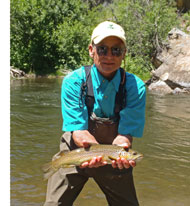
THE CHAMA: The upper stretches of the Chama are fishing well, if you hit it on the right day with the right fly patterns. The flows are quite low and the water is warm but the fishing is still quite good, especially in the morning and the late afternoon. Below El Vado and Abiqui dams, the water releases / flows are still too high and the water is very dirty. We are just waiting for the flows out of the dams to be cut back (usually around the beginning of September) and we should have epic fishing in these areas.
George C. with a wild brown from the upper Chama.
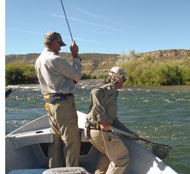
THE SAN JUAN: We have been fishing on the San Juan 6 or 7 days within the last couple of weeks and the fishing has been pretty darn good. We have done mostly float trips with a wade trip or two thrown in for good measure. As is often typical for this time of year, there isn't as much insect life or movement but this hasn't seemed to slow the fishing down. If you are in the right place with the right set-up, you will catch quite a few really nice fish. This is a great harbinger of things to come for the next month and on into the fall. With the cooler weather, the bateis and midges should start to hatch again, in fine form, which will turn the fish on in a big way. As good as the fishing is now, it should only get better as the fall progresses.
Putting one in the net on the drift boat..
OTHER RIVERS & STREAMS: Here are a few quick looks at some other rivers and streams in Northern New Mexico: THE RIO GRANDE isn't fishing that well right now with a bit higher, off-color water. The streams of the Jemez drainage (E. FORK & SAN ANTONIO) have been fishing fairly well but the water levels are very low. This makes the fish very spooky and harder to catch. Also, ash from the fires is always a looming issue now. THE PECOS finally has more water in it from the recent rains. The fishing is good with both wet and dry flies but the size run of fish seems to be pretty small.
|
 The Valles Caldera The Valles Caldera
Right now on the Valles Caldera National Preserve (VCNP), both the East Fork and the San Antonio are closed. The San Antonio will not be re-opened to fishing this season. The East fork may be re-opened later this month; depending on the conditions and health of the stream (they are tentatively talking about August 16th). The issue is that the Las Conchas fire burned a large portion of the East side of the preserve, where the headwaters of both streams are located.
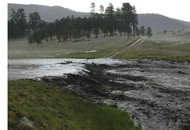 With the heavy rains that have occurred, there already have been some major issues with ash flows into the San Antonio. Due to the influx of ash into the streams, there definitely has been some fish mortality. Only time will tell how serious and widespread it is. The VCNP’s call to hold off on all fishing activities for now is very well-founded. We will just have to wait and see as far as what the situation on the re-opening of the East Fork this season will be.
The top picture was taken on the VCNP at the height of the Las Conchas fire. The bottom picture was taken just after a recent, heavy rainstorm. It shows how serious the flooding is and the heavy amount of ash that is entering into the San Antonio Creek's water.
|
 Fall Fishing in New Mexico Fall Fishing in New Mexico
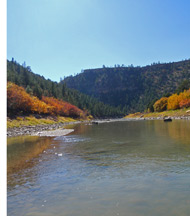
We wait all year long for September, October and November fishing in Northern New Mexico. The summer crowds have diminished; the water in the streams and rivers start to cool off; the brutally hot days of summer are gone and the fish really start to turn on. The brown trout become very aggressive, getting ready for their spawning season. This is the only time of year when you can consistently find and catch the larger fish that often seem to be non-existent throughout the rest of the year. The leaves of the cottonwood trees turn golden, making the banks of many rivers a wash of bright color. In the high country, the patches of aspen leaves turn as well, producing brilliant yellow spots among the dark green pines. Almost every stream and river will have clear water and reasonable flows. This is the best time of year to be out fishing.
Picture: Fall on the Chama.
|
 Tips & Skills ~ Set That Hook! Tips & Skills ~ Set That Hook!
It often seems that one of the most difficult fly fishing skills for folks to accomplish is setting the hook after a fish has hit their fly. The article below is excerpted from the literature we use in our classes. It especially applies to fishing the types of streams and river we have here in Northern New Mexico.
So your flies are dead-drifting along perfectly under your strike indicator and you are watching it like a hawk. Here is (hopefully) what happens next. You notice that the indicator jerks ever so slightly. You set the hook and you have a nice fish on. You fight the fish until you can net it - well done!
Let’s go over the whole process of what just happened, step by step, detailing it as we go...
1) Strike indicators maybe should be called "fish-on" indicators. What this means is that as soon as you see the indicator move, a fish has already taken any slack out of the leader and swum far enough to make the indicator jerk. So what this tells you is that: A) you always need to keep your eyes on the indicator or you will miss the strike; B) you need to set the hook immediately and C) you need to set the hook whenever the indicator moves, twitches or even just stops.
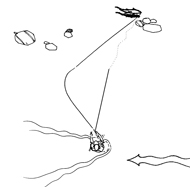
2) You have detected a strike and need to set the hook immediately; how do you do it? Basically setting the hook is a quick jerk of your fly rod to get the point of the hook “set” into the fish’s mouth. The best way to do this is to snap your wrist, moving the rod in a downstream direction. You don’t want to make a giant vertical sweep as if you were making a cast (often referred to as a “Hail Mary Strike” or "Bass Set" - it doesn’t work well). If you look at the illustration to the right, you will see that the fisherman has detected a strike and set the hook downstream with the current, keeping the rod on a horizontal plane. Considering that most of the time fish are pointing upstream when they are feeding, setting the hook this way often produces a better hook-set into the corner of a fish’s jaw.
Try to remember to make the hook-set like a quick, hard snap but not too strongly. If you set too hard, you run the risk of pulling the flies out of the fish's mouth and, if you are using lighter tippet, you can break it instantly. Another benefit to setting this way is that you won’t yank your flies out of the drift and, if you miss the fish, you will still be fishing. If you can learn to master this style of hook-setting, you will catch lots more fish. It takes practice and it helps to try and stay relaxed and not over react. Needless to say, this is easier said than done. Note: All of the same general setting principles apply for dry fly fishing. The only real difference is that sometimes, when fish are feeding on the surface slowly, you don’t want to make the hook-set as quickly as you would when fishing wet flies with an indicator.
|
|
Well that’s all for now. Give us a call anytime for up to date
fishing and weather conditions or just to say hi and "talk trout".
Stay Well,
Noah Parker
Land of Enchantment Guides
(505) 629-5688 or (505) 927-5356
| |
|
The Abeyta Ranch |
|
Here are some pictures, taken on the ranch within the last 2 weeks...
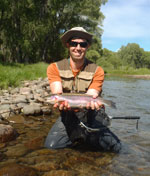
| |